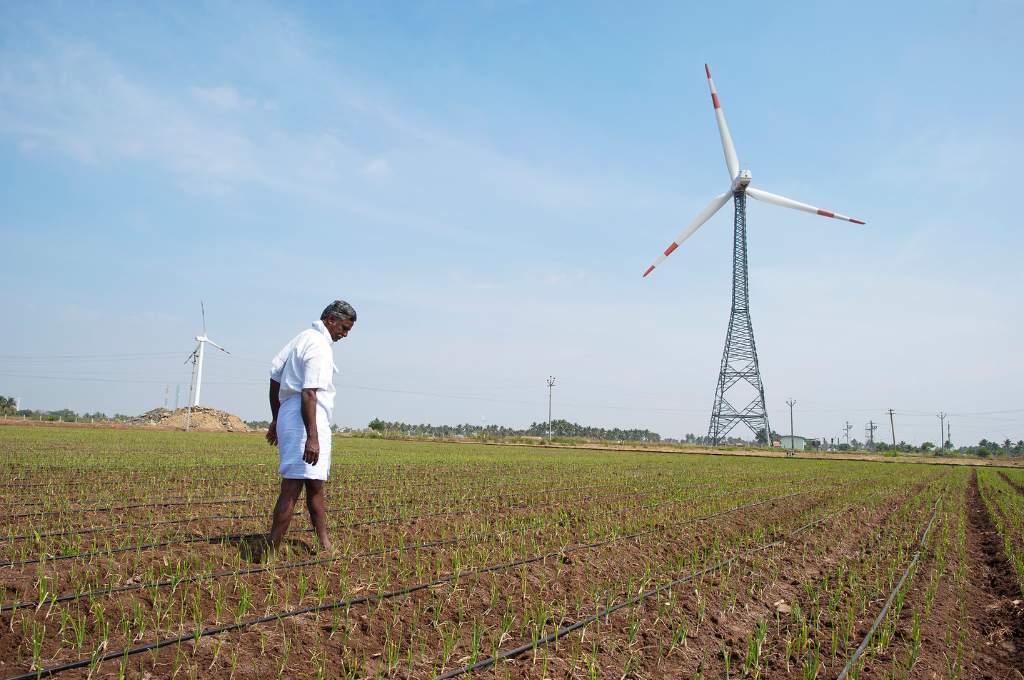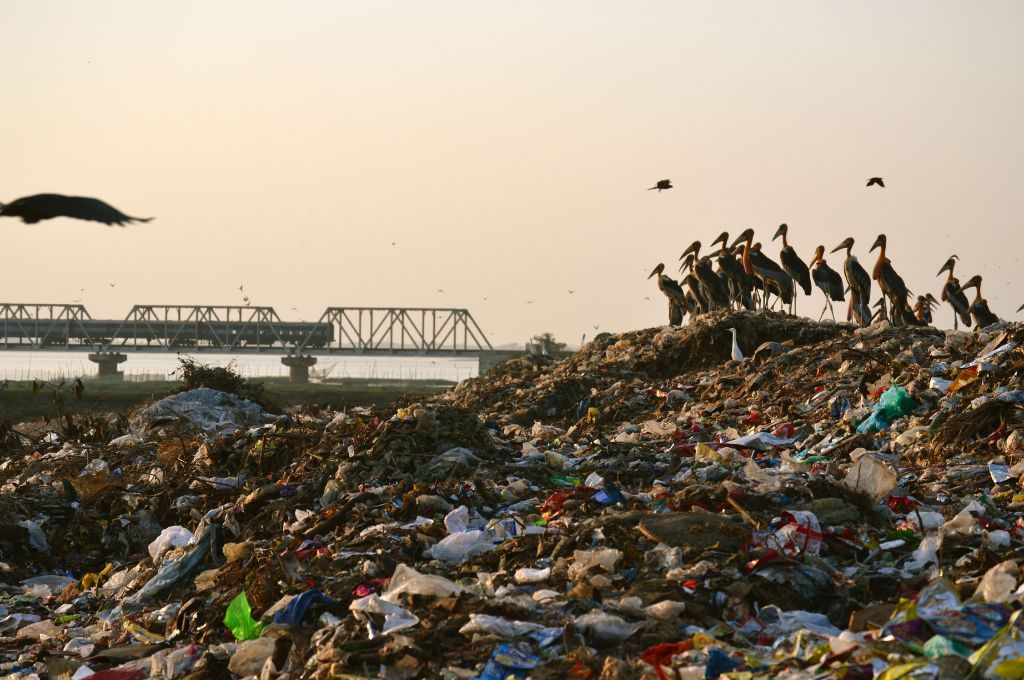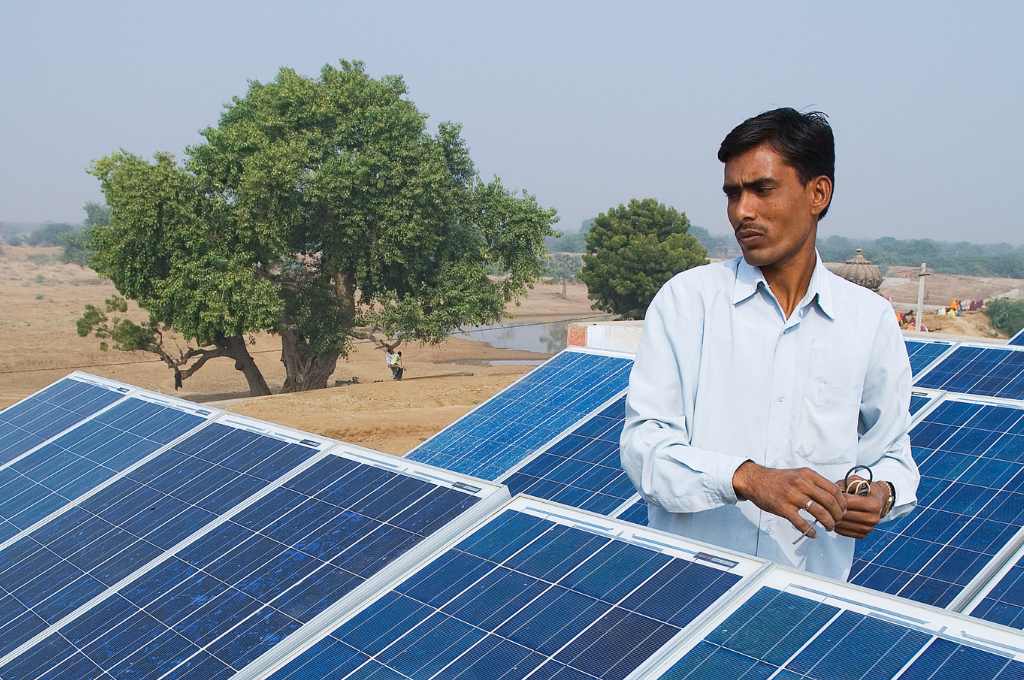By 2070—India’s target to achieving net zero—we will require three times more energy than we did in 2019, factoring for a population of 1.5 billion. This means installed capacity for renewables—a national programme already on the sprint with a target of 500 GW by 2030—will have to break into full gallop. According to a study by CEEW, installed solar capacity alone will have to cross 5,630 GW by 2070. For context, as of September 2023, India’s cumulative installed renewable energy (RE) capacity was 132.13 GW, of which solar accounted for 72.02 GW.
While renewable energy promises to hold off the planet’s carbon build-up and (hopefully) slow its climate meltdown, this is not the only outcome we need to consider. Renewable projects should be weighed as the sum of their parts, with the social and ecological costs of their value chains factored into the calculus—from the origin of their minerals to the disposal of their photovoltaic panels and turbine blades. They are infrastructure projects at the end of the day, dependent like any other on land, water, material, and labour, and the way they utilise these resources will determine how clean and green their energy is.
Ironically, words like ‘green’ and ‘clean’ prefixed to RE create blind spots that prevent us from recognising and solving for the detrimental impacts of these projects, a problem that is compounded by their exemption from certain land-use, water, and environmental regulations.
But because the sector is relatively young and amenable to change, there’s room to build out best practices that can contribute to driving an environment- and people-centric transition to clean energy. Here’s how it can be done.
1. Land and livelihood
The challenge
By one estimate, solar and wind infrastructure may need up to 95,000 sq km of land by 2050, an area equivalent to the size of Bihar. Land marks one of the key resources for the sector and its procurement through lease or acquisition takes top priority. In the past, however, land deals have sometimes left landowners and stakeholders—such as landless labourers, pastoralists, women, scheduled castes, and scheduled tribes—dissatisfied with the terms of the trade. Their grievances range from inadequate compensation to reneged promises of jobs to lost livelihoods.
Reports suggest that the potential for employment at mega solar power plants is often overestimated by contractors and brokers to encourage locals to give up their land. At the Pavagada Solar Power Park in Karnataka, for example, only one-tenth of the jobs promised by contractors have been made available to locals. Typically, the jobs are low-skill roles for panel cleaners, guards, and grass cutters, rather than skilled technical roles in installation, operations, and maintenance.
Social impact assessments have been cited as reasonable safeguards against negative community impacts, but it is typically the larger developers financed by foreign investors and multilateral development banks (MDBs) who are held accountable to these checks and measures. The exemption of the rest from these surveys can levy a social and economic toll on disaffected communities, who may end up rejecting or obstructing the project altogether.

An approach to consider
RE developers need to collaborate with the community to ensure that a project does more than extend short-term benefits for its long-term gains. It can do this by custom-building for the context, tailoring a project to the specific conditions of a site—whether social, cultural, or environmental—through business models that foreground social justice and economic resilience of the community.
Consistent and inclusive engagement can make this happen. By inviting people to articulate their concerns about livelihood and land use and working with them to arrive at solutions that are relevant to them, RE developers can emerge as genuine game changers in the region. They can harness local skills, hone them through skill-development and capacity-building programmes, and create sustainable livelihoods that assure permanent and scalable work. (According to the study ‘India’s Expanding Clean Energy Workforce’, the country’s solar and wind sectors have the potential to employ 1 million workers to meet the 500 GW goal.)
Also to be considered are multi-land use models like agrivoltaics, where land is utilised simultaneously to generate photovoltaic power and for agriculture. These adaptive approaches can limit the negative impact on farmer livelihoods and enable communities to retain a sense of ownership and connection to the land.
Developers and/or the state should also proactively plan for land-use change after the life cycle of the project, in order to ensure that it continues to contribute to local resilience. Constructive measures could be phased in gradually to test their effectiveness and to prevent a sudden escalation of costs for the developer.
2. Environment and biodiversity
The challenge
The large-scale procurement of land for solar projects can lead to spatial conflicts with the natural world. Biodiversity, for one, is lost when plant and animal life on pasturelands have to cede ground to solar panels. In the case of wind turbines, habitats are disrupted when land is levelled to erect towers and trees felled to widen roads for the passage of large turbine blades (more than 150 ft in length), particularly through wooded areas.
Some small hydroelectric power projects (less than 25 MW) have been known to produce a different domino effect. Studies have observed that—depending on the topography, soil, aquatic diversity, and biodiversity—the range of potential impacts can include river fragmentation, altered water chemistry, and diminished riverine fish stocks.
While India is yet to build a regulatory framework for solar and wind energy projects, their exemption from the Environment Impact Assessment Notification, 2020, can heighten the risks of habitat and biodiversity loss, and undermine the positive pay-off of clean energy. And when environment impact assessments (EIAs) are conducted at the behest of international investors, they often lack rigour and commitment. Checklists for junior staff, they end up focusing on a limited area rather than the whole landscape that the project stands to affect, and only home in on impacts evident at the time of evaluation rather than anticipate problems that may emerge over the 20–25-year lifespan of the project. Even when these assessments are conducted diligently and impartially, their results are not always prioritised by decision-makers.
An approach to consider
Sound EIAs can anticipate and mitigate ecological risks—displacement of wildlife, disruption of migratory routes, degradation of local vegetation, diversion of water sources—that could prove costly to the developer, the local community, and the ecosystem in the long run. An environmental assessment at Jaisalmer would have alerted wind and solar developers to the risks that overhead transmission lines pose to the critically endangered Great Indian Bustard, averting the additional cost of having to bury the cables below the ground later, on the orders of the Supreme Court.
Public consultations—requisite of EIAs—allow external evaluators to learn from local communities about ecological impacts and ecosystem services not immediately apparent to them. A stronger commitment to these assessments is therefore crucial. When foreseeable environmental impacts are flagged early on, it becomes easier for developers to devise solutions prospectively rather than retrospectively, saving them resources and time, and earning them local goodwill.
Developers can strengthen natural ecosystems, making them more resilient and productive.
In some parts of the world, ‘solar grazing’—where farmland-turned-solar parks now double as pasturelands—has yielded the dual benefits of improved soil quality and well-fed livestock. And so, by siting their projects in low-impact areas, planning these projects around local conditions, and introducing innovations at the design stage itself, developers can actually strengthen natural ecosystems, making them more resilient and productive.
3. Mining and recycling
The challenge
As the low-carbon energy sector grows, its appetite for minerals grows too. According to the International Energy Agency, the market for key transition minerals such as lithium, nickel, and cobalt has doubled from 2017 to 2022, spurred by the energy sector, and is expected to grow sixfold by 2050. Keen to secure the supply chain for its solar PV modules, wind turbines, and batteries, India has accelerated its mining programme and is preparing to tap new lithium deposits in Jammu and Kashmir, lithium being one of the critical minerals India imports.
But the adverse consequences of mining—polluted groundwater, respiratory diseases, human rights violations, child labour—remain the same from coal to cobalt, a problem made chronic by weak regulation. Without stringent mechanisms for oversight and accountability, the renewables sector may be as culpable of these charges as its hydrocarbons-based predecessor.
Another trapdoor the sector should be cautious of is the one that leads to the landfill. As India races to become a leading producer of RE, it is dogged by the spectre of the waste it stands to generate. Already the fourth largest producer of installed solar capacity, the country is predicted to produce 4 million tonnes of photovoltaic waste by 2050. The lifespan of a solar PV module is 25 to 30 years; that of a battery is three to 10 years (depending on its chemistry); and a wind turbine reaches end of life after 20 years. By 2050, the world will have 43 million tonnes of turbine blade waste on its hands.
However, RE components can turn to RE waste well before their expiry date. Damage can occur during transportation, installation, and operation, and due to weather events such as hail or storms. The lack of convenient and cost-effective mechanisms for solar waste disposal compels RE developers to store defunct PV panels at their facilities, risking their workforce and site to toxic leaching.
Panels and batteries that do pass through informal recycling channels expose waste handlers to hazardous elements such as lead, cadmium, tin, and antimony, compromising their health and safety, and that of the environment through contamination of surface and groundwater.

An approach to consider
Reducing waste, recovering usable material, and regenerating resources is key. There’s already stricter regulation around RE waste, with the E-Waste (Management) Rules 2022 making producers and manufacturers accountable for its safe processing and disposal.
The additional benefit of responsible recycling, apart from human and environmental safety, is the recovery of critical minerals and metals—which can account for 50 percent of the total material of the module. This plugs into India’s larger goal of resource autonomy, a project that gains particular significance in the face of global export controls on solar cell minerals. Some solar manufacturers are already taking the long view by setting up recycling units and extending recycling service agreements to developers.
The ideal approach is to design for circularity at the very outset.
However, recycling can only address part of the waste problem, for the quality of recoverable material reduces progressively through repeated processing. The ideal approach is to design for circularity at the very outset, with a view to extending the value and longevity of materials such as concrete, plastics, minerals, and metals required for RE components and infrastructure.
A circular value chain for the renewables sector would employ materials designed for optimum recovery, produced by clean technologies, and based on globally accepted design standards. The value chain itself would operate within a collaborative, cross-sectoral ecosystem for the quick and convenient repurposing of parts.
Some solar panel manufacturers in India are already moving towards circularity by manufacturing for maximum material recovery, which can be up to 90 percent of the module. If the value of a conventional panel was INR 100, recycling of these first-generation modules, which were not designed for extraction, would only fetch INR 2–3. But a panel worth INR 100, designed for recovery, might earn INR 30–40 after recycling. Making a strong business case for circularity could be one way to promote extended producer responsibility for manufacturers, and at the same time, identifying value and revenue streams early on can help defray decommissioning costs for developers.
Raising the bar
The past has taught us that speed and volume, with a business-as-usual approach, will only compound our problems in the future. The new energy economy must be more ambitious. What’s needed is a just and regenerative pathway, which comprehensive environmental, social, and governance (ESG) standards and strict regulatory policies can help pave. The lack of proper government regulation has made ESG criteria—mandated largely by foreign financiers and investors, MDBs, and corporate governance bodies like SEBI—the strongest guardrails for the sector.
But in the absence of standardised metrics and strict oversight, ESG criteria can be arbitrary, setting an uneven, sometimes low, often voluntary baseline for action that recommends reparation rather than reformation. However, RE businesses that proactively and pre-emptively set high standards for their operations will have a firmer foothold in their chosen location and become more resilient to unexpected challenges. They will align their business ambitions with broader socio-ecological objectives, and pursue them through participatory decision-making and transparent and fair supply chains.
Only then will renewable energy truly flip the switch.
With inputs from Saksham Nijhawan, Principal Strategist – Energy and Climate Change, Forum for the Future.
—
Know more
- Read this article to understand the social and ecological benefits of ‘wastelands’ and why they ought not to be the default choice for siting RE projects.
- Listen to this podcast to learn more about decentralised RE and its untapped potential for social inclusion.
- Read this article to know how old wind turbine blades can be creatively repurposed for public infrastructure.





